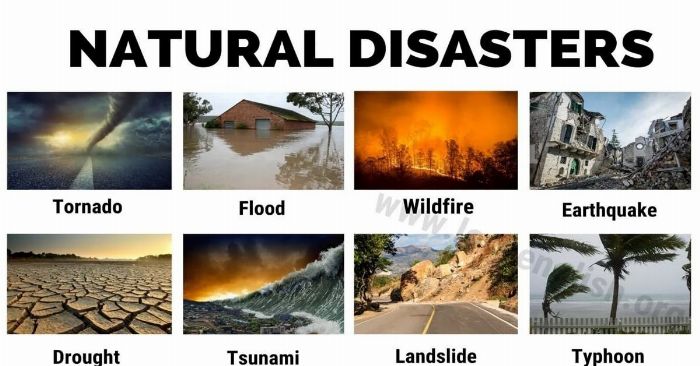If we look at the average over the past decade, approximately 50,000 people globally died every year from natural disasters — earthquakes, volcanic eruptions, hurricanes, tsunamis, floods, wildfires and droughts, each year. This represents around 0.1% of global deaths. This was, however, highly variable to high-impact events and ranged from 0.01% to 0.4% of total deaths.
The number of deaths from natural disasters can be highly variable from year-to-year; some years pass with very few deaths before a large disaster event claims many lives: the 1983-85 famine and drought in Ethiopia; the 2004 Indian Ocean earthquake and tsunami; Cyclone Nargis which struck Myanmar in 2008; and the 2010 Port-au-Prince earthquake in Haiti. All of these events pushed global disasters deaths over 200,000 – more than 0.4% of deaths in these years.

Violent natural disasters have been a fact of human life since the beginning of mankind, but the death counts of the most ancient of these disasters are lost to history. The ancient Mediterranean island of Thera (now Santorini, Greece), for example, experienced a catastrophic volcanic eruption that eradicated the entire Minoan civilization around 1600 B.C., according to a 2020 study published in the journal Proceedings of the National Academies of Sciences.
The effects of global warming
However, it is more than likely that the rate and magnitude of natural disasters will increase in the coming decades with the consequences of global warming.
Global warming is essentially caused by creating an abundance of greenhouse gases that get trapped in the atmosphere. Greenhouse gases, like carbon dioxide and methane, can be produced by burning fossil fuels to produce electricity through our industrial and agricultural processes and our modes of transportation.
With increasing global surface temperatures the possibility of more droughts and increased intensity of storms will likely occur. As more water vapor is evaporated into the atmosphere it becomes fuel for more powerful storms to develop.
More heat in the atmosphere and warmer ocean surface temperatures can lead to increased wind speeds in tropical storms. Rising sea levels expose higher locations not usually subjected to the power of the sea and to the erosive forces of waves and currents.
Combine drought-like conditions with record temperatures, summers that begin earlier and end later, and high winds, and you have the perfect conditions for wildfires that we have observed in recent years in California, Oregon (USA), Australia, south Europe, Russia, Brazil.
Recent natural disasters
Cyclone in Bangladesh, 1991 – 138,000
In 1991, a terrible disaster took place in the small country of Bangladesh. During the spring, a huge cyclone struck the Chittagong district, with huge winds blowing at over 250 kilometers per hour (155 mph). Those winds caused huge (6 meter / 19 feet) waves that have killed at least 138,000 people. However, the damage would be much larger if around 2 million people didn’t evacuate prior to the cyclone. Still, some people didn’t know where to go (and some simply didn’t want to), so many were killed, most by drowning. An estimated damage of $1,5 billion was caused to various buildings and properties. Entire villages were completely devastated, and the entire area suffered an economical crisis.
Earthquake in Japan, 1923 – 143,000
In 1923, an earthquake, later named Great Kanto eartquake, struck Japan’s Honshu island – the largest one of the four. The earthquake lasted somewhere between 5 and 10 minutes, and in that time caused massive amounts of collateral damage and killed many people. Earthquake’s magnitude was a big 7.9, measured using the moment magnitude scale. The earthquake hit during most people’s lunch times, which caused many fires to break out, some even turning into firestorms. Around 105,000 deaths are confirmed, with another 37,000 people missing, presumed dead. The total damage exceeded 1 billion dollars.
Floods in China, 1935 – 145,000
China’s Yangtze, the largest river in Asia, flooded and demolished a large area in China. Due to the river’s huge size, the floods took many casualties and caused great amounts of damage to the property and nature surrounding it. Almost 150,000 people are estimated to have died from the flooding, with many more injured. The people who stayed alive were heavily effected by the floods in a negative way – loss of income, less food, damaged properties, injuries, etc. Most recent Yangtze floods happened in 1998, however it caused much less death, with around 4,000 people dying during it.
Earthquake in Haiti, 2010 – 160,000
The most recent event on this list happened just 6 years ago in Haiti. A huge earthquake hit Haiti in January 2010, and broke many records with its devastation. It’s estimated that up to 160,000 people died during the earthquake, with many more being injured and otherwise affected. Due to the catastrophe happening in the modern age, many countries very able to aid Haiti with supplies, money and physical help. Haiti is one of the poorest countries of the world, and without massive help from other countries, it would never recover. Even with the aid, the recovery is still in progress.
Typhoon in China, 1975 – 229,000
Nina, that struck China in 1975, is the world’s 4th most deadly tropical cyclone that ever happened. Majority of the 229,000 deaths happened because of a dam that collapsed, which was a direct result of the typhoon and floods that were happening. Banqiao Dam was built to withstand a one-in-a-thousand flood, but it unfortunately wasn’t big enough to stop Nina mixed with a cold front. The estimated damage in 1975’s US dollars was somewhere around $1,2 billion, and close to 230,000 people have died as a result of the catastrophe taking place.
Earthquake in China, 1920 – 273,000
Another terrible that took place in China during the last century. 1920 Haiyuan earthquake was so powerful that it caused aftershocks even 3 years after it struck. The earthquake hit Chinese province Haiyuan County in December 1920, and caused a catastrophe. Over quarter of a million people died, and many rivers, fields and forests were demolished. However, that earthquake wasn’t the worst one that hit China, but more on that later.
Tsunami and Earthquake at the Indian Ocean, 2004 – 280,000
In 2004, Indian tectonic plate was subdued by the Burma Plate, triggering several intensive tsunamis to appear across the coast of the Indian Ocean. Fourteen countries were affected, with a total death toll of 280,000 people, with many more missing or injured. It is reported that the waves caused by the tsunamis were up to 30 meters (98 feet) in height, and that they’ve caused earthquakes in places far away (such as Alaska). For comparisons sake, the total energy released during the disaster was that of 15 atomic bombs that were dropped on Nagasaki and Hiroshima.
Cyclone in Bangladesh, 1970 – 375,000
The deadliest cyclone in the history of the earth happened in November 1970. A storm surge that happened caused anywhere between 250,000-500,000 people to die (we’ve taken the average for this list). At the height of their speed, storms were reaching up to 185 kilometers per hour (115 miles per hour). One of Bangladesh regions, Tazumudding lost almost half of its population during the catastrophe. The total damage was around 85 million USD, which is smaller than most on this list, but the death toll certainly makes up for it.
Earthquake in China, 1976 – 450,000
Just a year after the typhoon in 1975, another horrible disaster took place in China. The Great Tangshan earthquake that happened in 1976, struck a city with approximately million people. The earthquake, which lasted around 15 seconds, managed to cause severe property damage and take many human lives. The total estimated damage was around $1,5 billion (10 billion yuens). It is reported that hundreds of thousands of buildings were destroyed in the world’s deadliest earthquake of the modern age.
Floods in China, 1931 – Up To 4,000,000
The most deadly naturally-occurring disaster in the modern history also happened in China. In 1931, rivers Yangtze and Huai flooded the Republic of China, causing one of the world’s most tragic disasters in the entire history. It is estimated that anywhere between 1 and 4 million people lost their lives in the floods. Collateral damage was, of course, huge. The damage of the floods affected around 28,5 million people in total.
Most deadly natural disasters of the century
| Death toll (Highest estimate) | Event | Location | Date |
|---|---|---|---|
| 4,000,000 | 1931 China floods | China | July 1931 |
| 2,000,000 | 1887 Yellow River flood | China | September 1887 |
| 830,000 | 1556 Shaanxi earthquake | China | January 23, 1556 |
| 655,000 | 1976 Tangshan earthquake | China | July 28, 1976 |
| 500,000+ | 1970 Bhola cyclone | East Pakistan (now Bangladesh) | November 13, 1970 |
| 316,000 | 2010 Haiti earthquake | Haiti | January 12, 2010 |
| 300,000+ | 526 Antioch earthquake | Byzantine Empire (now Turkey) | May 526 |
| ≈300,000 | 1839 Coringa cyclone | Andhra Pradesh, India | November 25, 1839 |
| 273,400 | 1920 Haiyuan earthquake | China | December 16, 1920 |
| 229,000 | Typhoon Nina | China | August 7, 1975 |







